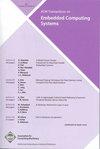基于分析模型的储能系统容量规划方法
IF 2.8
3区 计算机科学
Q2 COMPUTER SCIENCE, HARDWARE & ARCHITECTURE
引用次数: 0
摘要
大规模计算设施中的数据移动(从计算节点到数据节点)被归类为高成本和能源利用率的主要贡献者之一。为了解决这一问题,人们一直在积极探索存储设备(如固态硬盘)内的存储处理(ISP)。计算存储驱动器(csd)的引入使ISP具有与常规ssd相同的外形,并使替换传统计算节点中的ssd变得容易。使用csd,主机系统可以卸载各种操作,如搜索、筛选和计数。但是,商业化的cd具有不同的硬件资源和性能特征。因此,在计算节点内构建基于sd的存储系统时,需要仔细考虑硬件、性能和工作负载特征。因此,存储架构师对于构建基于ssd的存储系统犹豫不决,因为没有工具可以确定基于ssd的计算节点与基于ssd的传统节点相比在满足性能要求方面的优势。在这项工作中,我们提出了一个基于分析模型的存储容量规划器,称为CsdPlan,用于系统架构师构建性能有效的基于csd的计算节点。我们的模型考虑了主机系统的性能特征、目标工作负载以及要部署的csd的硬件和性能特征,并根据计算节点的csd数量提供最佳配置。此外,CsdPlan估算并降低了构建基于csd的计算节点的总拥有成本(TCO)。为了评估CsdPlan的有效性,我们选择了两个市售的csd和4个具有代表性的大数据分析工作负载。本文章由计算机程序翻译,如有差异,请以英文原文为准。
An Analytical Model-based Capacity Planning Approach for Building CSD-based Storage Systems
The data movement in large-scale computing facilities (from compute nodes to data nodes) is categorized as one of the major contributors to high cost and energy utilization. To tackle it, in-storage processing (ISP) within storage devices, such as Solid-State Drives (SSDs), has been explored actively. The introduction of computational storage drives (CSDs) enabled ISP within the same form factor as regular SSDs and made it easy to replace SSDs within traditional compute nodes. With CSDs, host systems can offload various operations such as search, filter, and count. However, commercialized CSDs have different hardware resources and performance characteristics. Thus, it requires careful consideration of hardware, performance, and workload characteristics for building a CSD-based storage system within a compute node. Therefore, storage architects are hesitant to build a storage system based on CSDs as there are no tools to determine the benefits of CSD-based compute nodes to meet the performance requirements compared to traditional nodes based on SSDs. In this work, we proposed an analytical model-based storage capacity planner called CsdPlan for system architects to build performance-effective CSD-based compute nodes. Our model takes into account the performance characteristics of the host system, targeted workloads, and hardware and performance characteristics of CSDs to be deployed and provides optimal configuration based on the number of CSDs for a compute node. Furthermore, CsdPlan estimates and reduces the total cost of ownership (TCO) for building a CSD-based compute node. To evaluate the efficacy of CsdPlan , we selected two commercially available CSDs and 4 representative big data analysis workloads.
求助全文
通过发布文献求助,成功后即可免费获取论文全文。
去求助
来源期刊

ACM Transactions on Embedded Computing Systems
工程技术-计算机:软件工程
CiteScore
3.70
自引率
0.00%
发文量
138
审稿时长
6 months
期刊介绍:
The design of embedded computing systems, both the software and hardware, increasingly relies on sophisticated algorithms, analytical models, and methodologies. ACM Transactions on Embedded Computing Systems (TECS) aims to present the leading work relating to the analysis, design, behavior, and experience with embedded computing systems.
 求助内容:
求助内容: 应助结果提醒方式:
应助结果提醒方式:


